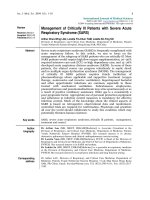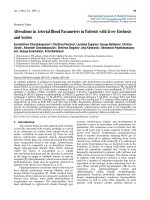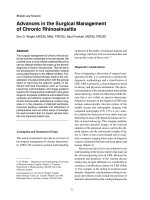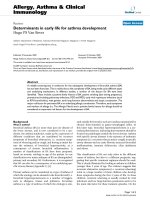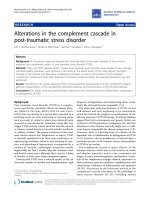Báo cáo y học: "Delirium in critically ill patients" ppsx
Bạn đang xem bản rút gọn của tài liệu. Xem và tải ngay bản đầy đủ của tài liệu tại đây (34.08 KB, 3 trang )
CAM-ICU = Confusion Assessment Method for the Intensive Care Unit.
Available online />Diagnosis of delirious patients in a critical setting is a difficult
task that is fraught with pitfalls. Any effort to address this
issue deserves mention, and that of Ely et al. [1] is certainly
no exception to this. Delirium in the ICU, an entity that is
associated with increased mortality, morbidity and duration of
stay [2–4], has recently attracted significant attention. The
misnomer ‘ICU psychosis’ has been abandoned and efforts
made to improve screening and diagnosis of delirium. These
are not straightforward tasks because it is clear that the
differential diagnosis of delirium is quite extensive [5], and
classical psychiatric evaluation is often impractical because
of the unique setting of the ICU and the clinical presentations
of critical care patients.
Efforts have thus been directed toward systematic screening
for delirious patients in the ICU [6]. Innovative ways to assess
cognition in patients who are unable to speak have been
developed [7]. However, assessment of delirium in a more
restricted group of ICU patients, such as those who are
mechanically ventilated, has not been evaluated until recently
[1]. Is it possible for the busy critical care nurse and physician
to have at their disposal a user-friendly, rapid and reliable tool
that allows them to diagnose delirium in this population?
The study
Ely et al. [1] addressed this difficult question in a
prospective cohort study of mechanically ventilated patients.
Those investigators attempted to achieve two objectives:
validation of the CAM-ICU and estimation of the occurrence
rate of delirium in this population. The CAM-ICU uses
standardized nonverbal assessments to evaluate four
features of delirium: acute onset or fluctuating course,
inattention, disorganized thinking and altered level of
consciousness.
A total of 80 patients (83.3%) out of the 96 evaluated
developed delirium. The CAM-ICU, administered by two
study nurses, had high sensitivity (93–100%), high specificity
(98–100%) and high inter-rater reliability (kappa = 0.96,
95% confidence interval 0.92–0.99) as compared with
assessment done by delirium experts who based their
diagnosis on the criteria of the Diagnostic and Statistical
Manual of Mental Disorders, fourth edition [8]. The CAM-ICU
also performed well when evaluating specific subgroups
(those aged ≥ 65 years, those with suspected dementia, and
those with Acute Physiology and Chronic Health Evaluation II
score ≥ 23). The mean time required to administer this test
Commentary
Delirium in critically ill patients
Nicolas Bergeron
1
, Yoanna Skrobik
2
and Marc-Jacques Dubois
3
1
Clinical Fellow, Department of Psychiatry, Service of Consultation-Liaison, Cabrini Medical Center, Mount Sinai School of Medicine, New York, USA
2
Intensivist, Critical Care Division, Maisonneuve-Rosemont Hospital, Montreal, Quebec, Canada
3
Research Fellow, Department of Intensive Care, Erasme Hospital, Free University of Brussels, Brussels, Belgium, and Intensivist, Critical Care Division,
University of Montreal Hospital, Montreal, Quebec, Canada
Correspondence: Marc-Jacques Dubois,
Published online: 5 April 2002 Critical Care 2002, 6:181-182
© 2002 BioMed Central Ltd (Print ISSN 1364-8535; Online ISSN 1466-609X)
Abstract
Delirium in the intensive care unit is a serious problem that has recently attracted much attention. User-
friendly and reliable tools, such as the Confusion Assessment Method for the Intensive Care Unit
(CAM-ICU), offer the clinician the opportunity to identify delirium in patients better. Diagnosis of
delirium in a critical care population is often a difficult task because classical psychiatric evaluation is
impossible for a number of reasons. The CAM-ICU makes use of nonverbal assessments to evaluate
the cardinal features of delirium (i.e. acute or fluctuating onset, inattention, disorganized thinking and
altered level of consciousness). Its development for use in the critical care setting represents a
significant advance that could lead to better care for such patients.
Keywords artificial, delirium, intensive care unit, respiration
Critical Care June 2002 Vol 6 No 3 Bergeron et al.
was 2 min. Ely et al. also showed that 10.4% of patients had
persistent delirium symptoms at hospital discharge.
Ely et al. [1] concluded that delirium is a frequent occurrence
in mechanically ventilated patients, and that CAM-ICU is a
rapid and valuable tool to diagnose this condition.
Comments
A new tool for nonpsychiatrists
Ely et al. [1] should be congratulated for this work. The
advantages of the CAM-ICU are clear and include ease of
administration and its high reliability. The most notable
contribution is the use of simple objective tests or scales that
are not dependent on the patient’s ability for verbal
expression to assess the presumed cornerstones of delirium
(i.e. altered level of consciousness, inattention, rapid onset
and fluctuating course). It would have been interesting to
know which CAM-ICU items were most commonly positive.
The high sensitivity and specificity reported are not
surprising, bearing in mind the fact that the CAM-ICU and
Diagnostic and Statistical Manual of Mental Disorders, fourth
edition [8] share almost identical elements. However, the
findings do suggest that a well trained nonpsychiatrist can
detect delirium reliably. Nonpsychiatrists are known to have a
potential for misdiagnosing delirium [9], but the CAM-ICU
could change this.
An important occurrence rate
Ely et al. [1] reported an occurrence rate of 80%, which is
higher than has been reported in the literature overall and in
other studies [2,6,10]. Such a discrepancy might in part be
explained by the nature of the studied population (medical,
surgical, or mixed; mechanically ventilated patients), use of
sedative and analgesic agents, and severity of illness. This
high occurrence rate for delirium also raises the issue of
delirium phenomenology in ICU. Alterations in levels of
consciousness and subsequent attention deficit are
frequent features of the critically ill population, largely
because these patients receive drugs that cause these
features. These constitute overlaps with characteristics in
the diagnosis of delirium.
One could also ask about the treatment that those patients
received. The authors mentioned a mean duration of delirium
of 2.4 days. Were the delirious patients treated according to
a standardized protocol?
From a purely statistical point of view it is clear that, although
the CAM-ICU has very good sensitivity and specificity,
positive and negative predictive values could change in a
setting in which the incidence of delirium were lower [11].
Finally, reinclusion of patients with a history of psychosis or
neurological disease (great ‘delirium mimickers’; excluded in
the study for validation purposes) could lower the specificity
of the CAM-ICU.
Impact
This elegant work calls for further study of delirium. First, we
need to have a more thorough view of risk factors for the
development of delirium in critically ill patients. A recent study
that used multivariate analysis [2] showed that hypertension,
smoking history, abnormal bilirubin and use of morphine are
associated with development of delirium. Another study [10]
showed that conditions such as respiratory disease,
infections, fever, anaemia, hypotension, hypocalcaemia,
hyponatraemia, azotaemia, elevated liver enzymes,
hyperamylasaemia, hyperbilirubinaemia and metabolic
acidosis were predicting factors for the development of
delirium. Some of those factors are difficult to modify
whereas others give insight into possible interventions.
Biochemical and metabolic aspects should not be neglected
because imbalances, for example in the insulin-growth
factor-1 and somatostatin axis, have been forwarded as
contributing factors to the development of delirium [12].
Approaches to the management of delirium have also been
relatively neglected. Basic recommendations include
treatment of the medical condition, correction of metabolic
disturbances, removal of offending agents and use of
antipyschotics. Haloperidol has been the most utilized [13],
but the use of new drugs with few side effects holds
promise [14].
Finally, the consequences of delirium need to be explored.
During the ICU stay delirium has been associated with
greater self-extubation and reintubation rates [2]. Ely et al. [3]
have also shown that delirious patients stayed longer in the
ICU. A recent study [15] showed that the occurrence of
delirium in older hospitalized patients was a strong
independent predictor of mortality [15]. Long-term
consequences of delirium must be carefully studied, and the
data reported by Ely et al. [1] are provocative and call for
further research in this field.
Conclusion
The study conducted by Ely et al. [1] is important and
pertinent to the diagnosis and management of delirium in the
ICU setting. We believe that every critical care nurse and
physician must try to incorporate tools to target and
diagnose delirious patients better. CAM-ICU may definitely
be one of them.
Competing interests
None.
References
1. Ely EW, Inouye SK, Bernard GR, Gordon S, Francis J, May L,
Truman B, Speroff T, Gautam S, Margolin R, Hart RP, Dittus R:
Delirium in mechanically ventilated patients: validity and relia-
bility of the confusion assessment method for the intensive
care unit (CAM-ICU). JAMA 2001, 286:2703-2710.
2. Dubois MJ, Bergeron N, Dumont M, Dial S, Skrobik Y: Delirium in
an intensive care unit: a study of risk factors. Intensive Care
Med 2001, 27:1297-1304.
3. Ely EW, Gautam S, Margolin R, Francis J, May L, Speroff T,
Truman B, Dittus R, Bernard R, Inouye SK: The impact of delir-
ium in the intensive care unit on hospital length of stay. Inten-
sive Care Med 2001, 27:1892-1900.
4. Inouye SK, Rushing JT, Foreman MD, Palmer RM, Pompei P:
Does delirium contribute to poor hospital outcomes? A three
site epidemiologic study. J Gen Intern Med 1998, 13:234-242.
5. Gallagher TJ: Physiology, pathophysiology, and differential
diagnosis of ICU agitation. Crit Care Med 2002, 30:S98-S101.
6. Bergeron N, Dubois MJ, Dumont M, Dial S, Skrobik Y: Intensive
Care Delirium Screening Checklist: evaluation of a new
screening tool. Intensive Care Med 2001, 27:859—864.
7. Hart RP, Levenson JL, Sessler CN, Best AM, Schwartz SM,
Rutherford LE: Validation of a cognitive test for delirium in
medical ICU patients. Psychosomatics 1996, 37:533-546.
8. American Psychiatric Association: Diagnostic and Statistical
Manual of Mental Disorders, 4th ed (DSM-IV). Washington, DC:
American Psychiatric Association; 1994.
9. Armstrong SC, Cozza KL, Watanabe KS: The misdiagnosis of
delirium. Psychosomatics 1997, 38:433-439.
10. Altman DG: Practical Statistics for Medical Research. Boca
Raton, London, New York, Washington: Chapman and Hall/CRC,
1999.
11. Aldemir M, Ozen S, kara IH, Sir A, Bac B: Predisposing factors
for delirium in the surgical intensive care unit. Crit Care 2001,
5:265-270.
12. Broadhurst C, Wilson K: Immunology of delirium: new opportu-
nities for treatment and research. Br J Psychiatry 2001, 179:
288-289.
13. Trzepacz P, Breibart W, Levenson J, Franklin J, Martini DR, Wang
P: Practice guideline for the treatment of patients with delir-
ium. Am J Psychiatry 1999, 156:S1-S20.
14. Anand HS: Olanzapine in an intensive care unit [letter]. Can J
Psychiatry 1999, 44:397.
15. McCusher J, Cole M, Abrahamowicz M, Primeau F, Belzile E:
Delirium predicts 12-month mortality. Arch Intern Med 2002,
162:457-463.
Available online />
